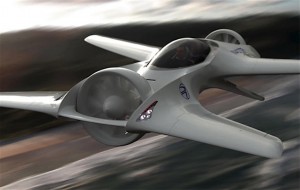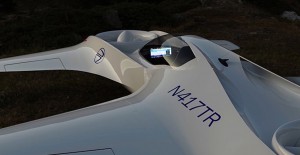
The DeLorean DR-7 is the latest entry into the flying car segment, or it will be when it arrives in late 2018.
Reminisce about the ’80s and it won’t take long for memories to move to flying DeLoreans, 1.21 jigawatts and hitting 88 mph.
Fast forward a few decades and there is still talk of flying DeLoreans. Only now, they don’t travel through time, but they do fly autonomously. At least, that the goal of DeLorean Aerospace, which is just the latest company to enter the flying car market.
The company, which was founded in 2012, is run by Paul DeLorean, nephew of the iconic car’s namesake and well-known auto executive John DeLorean. And it’s working what it calls “vertical takeoff and landing personal transports.”
Called the DR-7, the all-electric vehicle has an estimated range of 120 miles at 150 mph, although the top speed is expected to be 240 mph.
(Volvo parent Geely buys Terrafugia flying car company. For the story, Click Here.)
Of course, it’s estimated at this point because the company has built just two prototypes: a small drone-sized model to make sure it would work and a larger, one-third scale model, which hit all of its marks.
Fortunately, it doesn’t look much like a DeLorean and isn’t powered by Mr. Fusion. Like other flying cars, such as the Terrafugia and others, in that it has wings and propellers, although in this case they’re more like fans.
The carbon-composite body has two sets of wings, front and back, as well as smaller wings under the tandem seats – yup, you and a friend can fly – as well as a large fan in the front and another in the back. They fans swivel 360 degrees to handle take off and landing as well as propulsion. In this configuration, there is no need for a rudder, reduces drag and allows for the higher speed.
(Click Here for more on Uber Elevate.)
DeLorean has built a non-working model that is 30 feet long and 18.5 feet wide, but it’s expected to fold up enough to fit in a large garage.
All of this doesn’t include the fact that it’s a battery-electric vehicle that won’t require a pilot’s license because it will be autonomous. No details have been released on how that will work, but the company’s set a target date for late 2018 for a working model.
In the meantime, others will be hustling their own vehicles together, such as the aforementioned Terrafugia as well as Uber, which plans to Uber is also working on building flying cars in a similar project, Uber plans have its flying car, Uber Elevate, ready in three years.
(Has the era of the flying car finally arrived. Click Here for more.)
Terrafugia may be on the different path as it was purchased earlier this year by Volvo’s parent company, Geely. Funding from Zhejiang Geely could be what’s needed to push Terrafugia over the top, especially as it now faces a range of competitors hoping to take off with their own flying car and flying taxi concepts. That includes Slovakian start-up AeroMobil and Germany’s Lilium, as well as aerospace giant Airbus.

